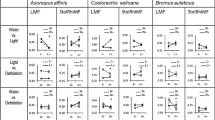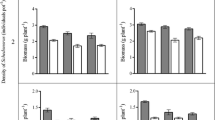Summary
Morphologically distinct populations of a North American perennial grass, Agropyron smithii, collected from a heavily grazed prairie dog (Cynomys ludovicianus) colony (PDC) and a grazing exclosure (EX), were grown in an environmental chamber to determine whether: (1) leaf silicon (Si) concentrations are greater in plant populations which differentiated under heavy grazing pressure, and (2) leaf silicification is inducible by defoliation. Mean shoot Si concentration of nondefoliated plants was greater in the PDC population (2.2%) than the EX population (1.9%) over the 18 wk experiment, largely as a result of differences in Si concentrations in leaf blades. However, leaf Si concentration was lower in defoliated plants of each population than in nondefoliated plants, indicating that leaf silicification was not an inducible herbivore defense mechanism in A. smithii. The higher leaf Si concentrations from the heavily grazed population may be associated with grazingrelated environmental stresses such as a warmer, drier microclimate or with morphological characteristics related to grazing tolerance or avoidance.
Similar content being viewed by others
References
Archer S, Detling JK (1986) Evaluation of potential herbivore mediation of plant water status in a North American mixed-grass prairie. Oikos 47:287–291
Brizuela MA, Detling JK, Cid MS (1986) Silicon concentration of grasses growing in sites with different grazing histories. Ecology 67:1098–1101
Carman JG, Briske DD (1985) Morphological and allozymic variation between long-term grazed and non-grazed populations of the bunchgrass Schizachyrium scoparium var. frequens. Oecologia 66:332–337
Cheng BT (1982) Some significant functions of silicon to higher plants. J Plant Nut 5:1345–1353
Coppock DL, Detling JK, Ellis JE, Dyer MI (1983a) Plant-herbivore interactions in a North American mixed-grass prairie. I. Effects of black-tailed prairie dogs on intraseasonal aboveground plant biomass and nutrient dynamics and plant species diversity. Oecologia 56:1–9
Coppock DL, Ellis JE, Detling JK, Dyer MI (1983b) Plant-herbivore interactions in a North American mixed-grass prairie. II. Responses of bison to modification of vegetation by prairie dogs. Oecologia 56:10–15
Coughenour MB (1985) Graminoid responses to grazing by large herbivores: adaptations, exaptations, and interacting processes. Ann Missouri Bot Gard 72:852–863
Day TA (1988) Modification of individual plant and community water and nitrogen relations by grassland herbivores. Ph.D. Dissertation. Colorado State University, Fort Collins, Colorado
Detling JK, Painter EL (1983) Defoliation responses of western wheatgrass populations with diverse histories of prairie dog grazing. Oecologia 57:65–71
Detling JK, Painter EL, Coppock DL (1986) Ecotypic differentiation resulting from grazing pressure: evidence for a likely phenomenon. In: Joss PJ, Lynch PW, Williams OB (eds) Rangelands: a resource under siege. Proceedings of the Second International Rangeland Congress. Australian Academy of Science, Canberra, pp 431–433
Djamin A, Pathak MD (1967) Role of silica in resistance to Asiatic rice borer, Chilo suppressalis (Walker), in rice varieties. J Econ Entomol 60:347–351
Fox RL, Silva JA, Plucknett DL, Teranishi DY (1969) Soluble and total silicon in sugar cane. Plant Soil 30:81–82
Handreck KA, Jones LHP (1968) Studies of silica in the oat plant. IV. Silica content of plants parts in relation to stage of growth, supply of silica and transpiration. Plant Soil 29:449–459
Jaramillo VJ, Detling JK (1988) Grazing history, defoliation, and competition: effects on shortgrass production and nitrogen accumulation. Ecology 69:1599–1608
Johnson LF, Curl EA (1972) Methods for research on the ecology of soil-borne plant pathogens. Burgess Publ. Co., Minneapolis MN
Krueger K (1986) Feeding relationships among bison, pronghorn and prairie dogs: an experimental analysis. Ecology 67:760–770
Lanning FC, Linko Y (1961) Absorption and deposition of silica by four varieties of sorghum. Agric Food Chem 9:463–465
Levin DA (1976) The chemical defenses of plants to pathogens and herbivores. Ann Rev Ecol Syst 7:121–159
Mahmoud A, Grime JP, Fruness SB (1975) Polymorphism in Arrhenatherum elatilus (L.). Beauv. ex J.& C. Presl. New Phytol 75:269–276
Marschner H (1986) Mineral Nutrition of Higher Plants. Academic Press. London
McNaughton SJ, Tarrants JL (1983) Grass leaf silicification: Natural selection for an inducible defense against herbivores. Proceedings of the National Academy of Science. USA 80:790–791
McNaughton SJ, Tarrants JL, McNaughton MM, Davis RH (1985) Silica as a defense against herbivory and a growth promoter in African grasses. Ecology 66:528–535
Mengel K, Kirkby EA (1978) Principles of Plant Nutrition. Int. Potash Inst., Bern, Switzerland
Minson DJ (1971) The digestibility and voluntary intake of six varieties of Panicum. Aust J Expt Agric Animal Husbr 11:18–25
Morton BC, Jutras MW (1974) Silica concentrations in grazed and ungrazed forage species. Agron J 66:10–12
Painter EL (1987) Grazing and intraspecific variation in four North American grass species. Ph.D. Dissertation. Colorado State University, Ft. Collins, Colorado
Polley HW, Detling JK (1988) Herbivory tolerance of Agropyron smithii populations with different grazing histories. Oecologia 77:261–267
Scott AW, Whalley RDB (1984) The influence of intensive sheep grazing on genotypic differentiation in Danthonia linkii, D. richardsonii and D. racemosa on the New England Tablelands. Aust J Ecol 9:419–429
Stebbins GL (1981) Coevolution of grasses and herbivores. Ann Missouri Bot Gard 68:75–86
Van Bavel CHM, Lascano R, Wilson DR (1978) Water relations of fritted clay. Soil Sci Soc Amer Proc 42:647–659
Van Soest, P.J. (1982) Nutritional Ecology of the Ruminant. O&B Books, Inc., Corvallis, Oregon
Wadham MD, Parry DW (1981) The silicon content of Oryzasativa L. and its effect on the grazing behaviour of Agriolimax reticulatus Muller. Ann Bot 48:399–402
Warwick SI (1980) The genecology of lawn weeds VII. The response of different growth forms of Plantago major L. and Poa annua L. to simulated trampling. New Phytol 85:461–469
Williams GJ III, Kemp PR (1978) Simultaneous measurement of leaf and root gas exchange of short-grass prairie species. Bot Gaz 139:150–157
Wydeven AP, Dahlgren RB (1985) Ungulate habitat relationships in Wind Cave National Park. J Wildl Manage 49:805–813
Author information
Authors and Affiliations
Rights and permissions
About this article
Cite this article
Cid, M.S., Detling, J.K., Brizuela, M.A. et al. Patterns in grass silicification: response to grazing history and defoliation. Oecologia 80, 268–271 (1989). https://doi.org/10.1007/BF00380162
Received:
Issue Date:
DOI: https://doi.org/10.1007/BF00380162




